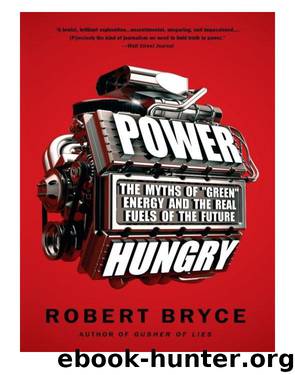Power Hungry by Robert Bryce

Author:Robert Bryce
Language: eng
Format: epub
Publisher: PublicAffairs
Published: 2011-03-03T05:00:00+00:00
Sources: BP Statistical Review of World Energy 2009, http://www.bp.com/liveassets/bp_internet/globalbp/globalbp_uk_english/reports_and_publications/statistical_energy_review_2008/STAGING/local_assets/2009_downloads/renewables_section_2009.pdf; ICF International, Table 7, “Availability, Economics, and Production Potential of North American Unconventional Natural Gas Supplies,” November 2008, http://www.ingaa.org/cms/31/7306/7628/7833.aspx, 51; Navigant Consulting, “North American Natural Gas Supply Assessment,” July 4, 2008, http://www.cleanskies.org/upload/MediaFiles/Files/Downloads2/finalncippt2.pdf, 14; Potential Gas Committee, “Potential Gas Committee Reports Unprecedented Increase in Magnitude of US Natural Gas Resource Base,” June 18, 2009, http://www.mines.edu/Potential-Gas-Committee-reports-unprecedented-increase-in-magnitude-of-US-natural-gas-resource-base.
While the resources-versus-reserves caveat applies, the enormous gas estimates being put forward are part of a new gas paradigm that is based on abundant supplies of methane in a marketplace that is increasingly global. The growing globalization of gas can be seen by looking at the surge in trade of liquefied natural gas. Between 2000 and 2007, global trade in LNG increased by 67 percent.39 And more LNG trade is on the way. By 2013 or so, the IEA expects global LNG production capacity to increase by about 50 percent.40 And yet more gas liquefaction capacity is being planned.
In October 2009, the British-Dutch energy giant, Shell, announced plans to build a floating natural gas liquefaction facility that, when completed, will be deployed off the northwestern coast of Australia. The vessel, expected to cost about $5 billion, will be nearly 500 meters long and will be designed to monetize what the industry calls “stranded” gas, that is, gas that is in fields that are either too small or too far from commercial centers to justify the construction of pipelines or conventional gas liquefaction facilities. Australia alone has some 140 trillion cubic feet of stranded gas, and Shell may build as many as ten floating LNG production vessels, which could allow Australia and other countries to turn their stranded gas into cash. In addition to Shell, Japan’s Inpex Holdings and Australia’s Santos are also considering floating LNG projects.41
In November, Petrobras, the Brazilian energy giant, announced that it, too, is planning to build floating natural gas liquefaction facilities in order to bring ashore the massive amounts of gas that it has discovered in the Santos Basin, one of Brazil’s huge offshore hydrocarbon reservoirs. The company said the floating platforms will operate about 190 miles offshore and will allow the offshore gas reserves “to be monetized, ensuring flexibility to supply the internal market and the possibility of exporting the product in the spot market.”42
The new LNG production capacity is coming onstream at the same time that, thanks to the boom in shale gas production, America’s need for LNG imports has largely disappeared. That point was made succinctly by Ian Cronshaw, a gas analyst at the IEA, who said that the United States was “now a virtual liquefied natural gas exporter because all the LNG that was supposed to be going there is now going somewhere else.”43
The increasing globalization of the LNG market is occurring at the same time that the technologies for producing gas from shale are going global. In Canada, drillers have begun tapping two massive shale formations, Horn River and Montney.44 Those resources are so big that there is even
Download
This site does not store any files on its server. We only index and link to content provided by other sites. Please contact the content providers to delete copyright contents if any and email us, we'll remove relevant links or contents immediately.
| Automotive | Engineering |
| Transportation |
Whiskies Galore by Ian Buxton(41726)
Introduction to Aircraft Design (Cambridge Aerospace Series) by John P. Fielding(33022)
Small Unmanned Fixed-wing Aircraft Design by Andrew J. Keane Andras Sobester James P. Scanlan & András Sóbester & James P. Scanlan(32692)
Craft Beer for the Homebrewer by Michael Agnew(18087)
Turbulence by E. J. Noyes(7901)
The Complete Stick Figure Physics Tutorials by Allen Sarah(7273)
Kaplan MCAT General Chemistry Review by Kaplan(6830)
The Thirst by Nesbo Jo(6769)
Bad Blood by John Carreyrou(6483)
Modelling of Convective Heat and Mass Transfer in Rotating Flows by Igor V. Shevchuk(6359)
Learning SQL by Alan Beaulieu(6166)
Weapons of Math Destruction by Cathy O'Neil(6090)
Man-made Catastrophes and Risk Information Concealment by Dmitry Chernov & Didier Sornette(5883)
Digital Minimalism by Cal Newport;(5593)
Life 3.0: Being Human in the Age of Artificial Intelligence by Tegmark Max(5410)
iGen by Jean M. Twenge(5333)
Secrets of Antigravity Propulsion: Tesla, UFOs, and Classified Aerospace Technology by Ph.D. Paul A. Laviolette(5244)
Design of Trajectory Optimization Approach for Space Maneuver Vehicle Skip Entry Problems by Runqi Chai & Al Savvaris & Antonios Tsourdos & Senchun Chai(4962)
Electronic Devices & Circuits by Jacob Millman & Christos C. Halkias(4871)
